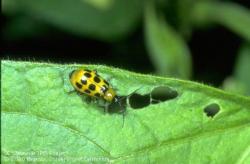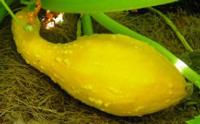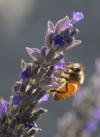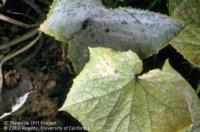Squash, problems
-
Holes in leaves

If you notice holes in leaves of squash, beans, cucumbers, and other vegetables, you may be seeing damage from the cucumber beetle.Cucumber beetles are very common pests in vegetable gardens and may also attack ripening stone fruit. The most common in California is the western spotted cucumber beetle. Adult beetles are about 0.25 inches long, greenish yellow with twelve black spots on their back and long antennae.
Larvae feed exclusively on roots, but do not generally damage garden plants, although corn may occasionally be damaged.
Solutions
Management of cucumber beetles is difficult. Most older plants can support substantial numbers without serious damage. The best strategy for most vegetable gardens may be to place protective cloth over emerging plants and remove it when plants are old enough to tolerate damage.
Various natural enemies and general predators are known to attack cucumber beetles.Learn more about natural enemies and general predators.
Read more about cucumber beetles.Poor fruit set
Squash and other members of this family will not mature successfully if their flowers are not pollinated. Hunter Johnson Jr., Extension Vegetable Specialist, University of California, Riverside describes the situation and highlights our dependence on bees for pollination:
Squash, melons, and cucumbers belong to the same family, often called ‘cucurbits,’ and have a flowering habit which is unique among the vegetable crops. They bear two kinds of flowers, male and female, both on the same plant. In order for fruit set to occur, pollen from the male flower must be transferred to the female flower. The pollen is sticky; therefore, wind-blown pollination does not occur.
Honeybees are the principal means by which pollen is transferred from the male to the female flower. Other insects cannot be depended upon for pollination. If only a few bees are present in the area, partial pollination may occur, resulting in misshapen fruit and low yield. When no bees are present in the garden or the bee population is too low for good fruit set, the dedicated gardener can substitute for the bee by pollinating by hand. Hand pollination is a tedious chore, but it is the only means of obtaining fruit set in the absence of bees.
The female flower in cucurbits can be recognized easily by the presence of a miniature fruit (ovary) at the base of the flower. Female squash flowers are much larger than the female flowers on melon and cucumber plants. The male squash flower can be identified by its long, slender stem. The female squash flower is borne on a very short stem.
Gardeners often become concerned when many flowers appear early, but fruits fail to set. The reason for this is that all of the early flowers are males. Female flowers develop somewhat later and can be identified by the miniature fruit at the flower base. In hybrid varieties of summer squash, however, the first flowers to appear are usually females, and these will fail to develop unless there are male squash flowers -- and bees -- in the nearby area.Read more details about fruit set in squash.
Read more about Summer squash production in California. This article was written by several University of California Cooperative Extension Farm Advisors and discusses key essentials that affect the growing of squash in California, one of which is poor pollination.What to do? Plant ‘bee friendly’. There are many on-line sources containing lists of bee-friendly plants, such as:
Plant a Bee Garden
Urban Bee Gardens
Planting natives is also a good way to encourage bees to come to your garden.
Powdery Mildew
Powdery mildew is caused by fungi. All members of the cucurbit family (squash, pumpkin, cucumber, melon) are susceptible to powdery mildew. Powdery mildew first appears as pale yellow spots on stems and leaves. These spots enlarge, white, fluffy growth appears on plant surfaces, and spores are produced. Affected leaves become dull, yellow, and may wilt in the afternoon heat; eventually they become brown and papery. Plants may die.All powdery mildew fungi grow on living plant tissue; most grow on the surface of the affected plant part. Spores are the primary means of dispersal, and are carried by the wind to new hosts. All powdery mildew species can germinate and infect in the absence of water. Moderate temperatures and shady conditions are generally the most favorable for development of infection. Spores are sensitive to extreme heat and direct sunlight.
Solutions
Control weeds and keep the garden clean; avoid overhead sprinklers. Powdery mildew can be eradicated by application of horticultural oil or neem oil. Be careful not to apply oils when the temperatures are high (above 80 degrees F). Another option, although less effective than oils, is to use a bacterial-based spray such as Serenade.
Read more about Powdery Mildew.
Read more about other common problems of squash.




